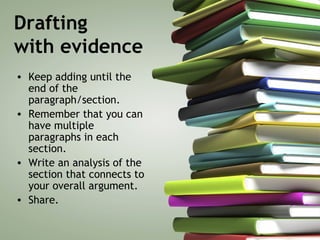The document provides guidance on drafting a research paper, including organizing data, drafting different sections such as results and discussion, and choosing and presenting evidence. It emphasizes connecting each paragraph to the overall argument, providing context and analysis for evidence, and considering implications and relevance in the conclusion. Students are advised to follow common research paper structures and formatting conventions.










![Drafting
with evidence
• Evidence
– “When I asked what they think about
creativity when it comes to writing,
Matt responded that he “has learned to
write his papers to earn the grade that
he needs,” a remark with which Erica
agreed. This answer led the group into
a conversation about creative writing in
which Michael stated that creativity is
relative to the class situation. He
explained that a creative writing class
heavily values creativity in writing
more than an entry level English class
does. Erica, however, responded,
“Even in creative writing classes you
have to follow what [the instructors]
want, so you can’t exactly write the
way you want.”](https://image.slidesharecdn.com/enc1102draftingresearchpaper-101122053556-phpapp02/85/Enc1102-drafting-research-paper-11-320.jpg)







![Let’s occupy
the niche.
“Much has been discussed on the
topic of creativity and literacy instruction
from a teacher’s standpoint. The perception
among these teachers (and most teachers, for
that matter) is that creativity must be allowed
to flourish in a classroom setting. And most
teachers are, in fact, applying creative
methods in their writing instruction. What is
missing from this conversation, however, is
the most important voice: the student’s. How
do students perceive the use of creativity in a
classroom setting?”
(conclusion to lit review; pointing to research question.)
• You could (and probably should)
outline research/findings here:
– “In order to answer this question, I
conducted a study in which I [brief
description of methods]. My findings
suggest that [preview of findings].”](https://image.slidesharecdn.com/enc1102draftingresearchpaper-101122053556-phpapp02/85/Enc1102-drafting-research-paper-19-320.jpg)



